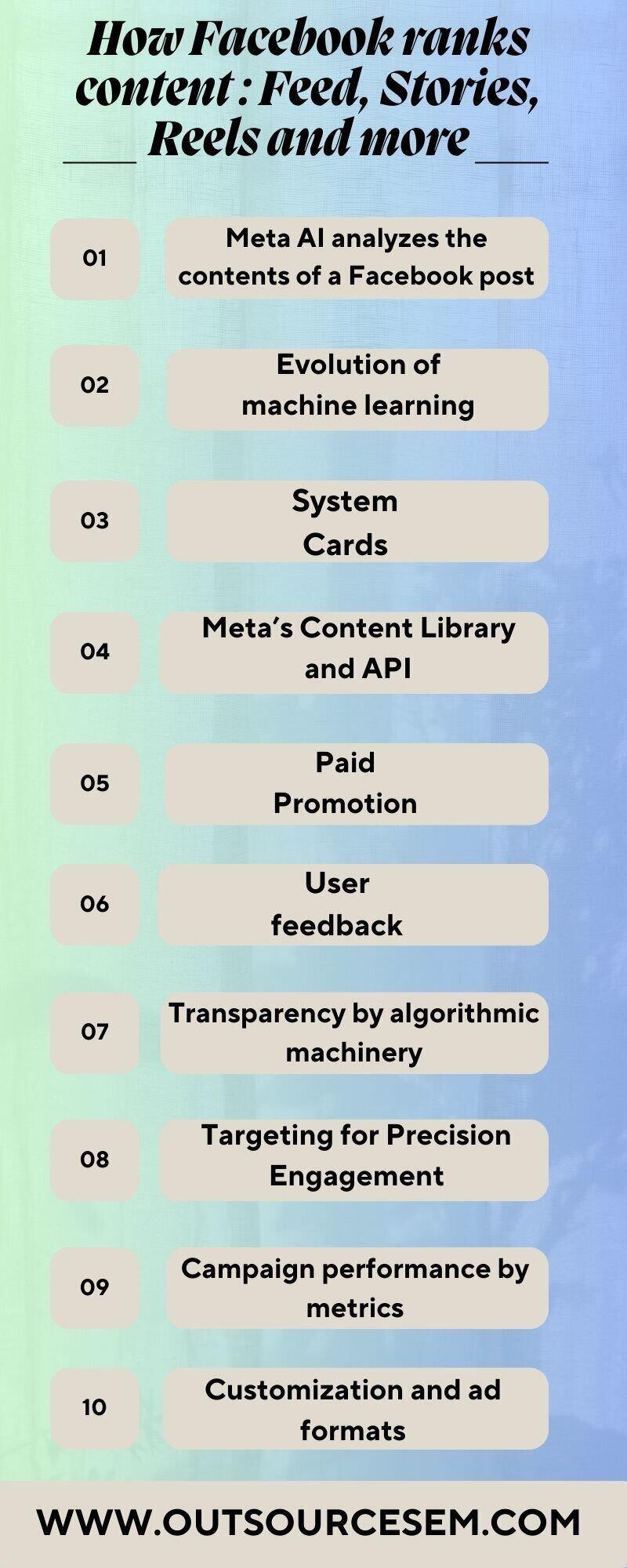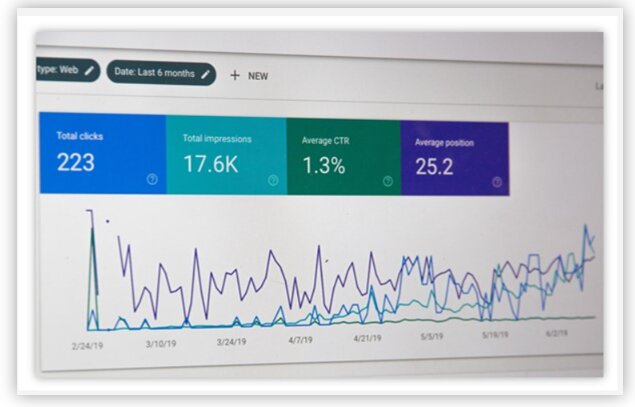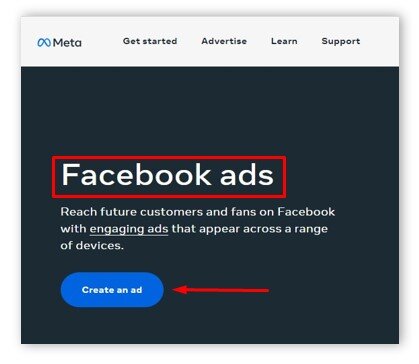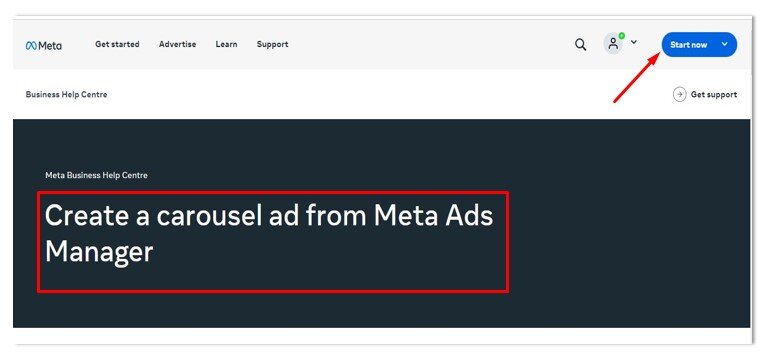Facebook is a trailblazer in the dynamic world of social media, uniting billions of users worldwide. An intricate algorithm shapes content presentation on feeds, stories, and reels behind the fluid scrolling experience. It creates a one-of-a-kind content journey that goes beyond traditional marketing. Facebook prioritizes transparency and user control with innovations such as system cards and Meta's Content Library. In this blog article, unravels the algorithmic tapestry, delving into the layers that shape your Facebook experience and contribute to the vibrant global conversation.
How Facebook ranks content: Feed, stories, reels and more.

1. Meta AI analyzes the contents of a Facebook post
Facebook content ranking system is a key pillar of the platform's quest to provide a personalized and engaging user experience. The Facebook artificial intelligence evaluates and prioritizes content based on three fundamental factors, each of which contributes to the intricate dance of content visibility:
A. Affinity - Affinity, a foundational component of the Meta’s AI ranking algorithm, quantifies the relationship between a user and a content creator. It works on the premise that the more interactions a user has with the content of a specific creator. This metric is critical in determining users' likelihood of seeing posts from that content creator in their feed. It's a digital closeness metric that adapts dynamically as user interactions change.
B. Weight - The algorithm introduces the concept of 'Weight' to distinguish between different types of engagement. A like, comment, or share is not treated equally; each action has its own weight assigned to it. Shares, for example, are more valuable than likes because they indicate a more profound endorsement of the content. This nuanced approach ensures that user engagement is not simply counted but weighed in terms of its impact on content visibility.
C. Time decay - The Facebook ranking algorithm recognizes the importance of timeliness in the ever-changing world of social media. Freshness is associated with relevance, and the algorithm considers a post's recentness a critical factor. Recent updates take precedence over older ones, reflecting the dynamic nature of user interests and ensuring that users see the most current and contextually relevant content.

2. The evolution of machine learning
Facebook's algorithm evolves in the team with technological advancements. The integration of machine learning augments and refines the traditional EdgeRank principles. This technological advancement enables the algorithm to transcend static rules and understand the complexities of individual user behavior. Machine learning examines user preferences, considering behaviors, interests, and engagement patterns. As a result, the algorithm learns and adapts to deliver content that resonates with each user's unique preferences, resulting in a more nuanced and personalized user experience.
3. System Cards
Meta has introduced a set of 14 system cards to increase transparency and empower marketers and users. These cards are invaluable resources for understanding how artificial intelligence (AI) shapes content ranking and, in turn, influences personalized feeds. Meta aims to give users more control over their content preferences by providing insights into the factors at play.
The recently introduced system cards offer a comprehensive breakdown of how Facebook's algorithm operates across various content sections:
i. Feed - In the Feed section, AI takes center stage, calculating a relevance score for approximately 500 posts. The emphasis here is prioritizing content type diversity, preventing users from seeing consecutive displays of similar posts. This results in a more complete and engaging feed experience.
ii. Reels - AI becomes a predictive force in the Reels section, anticipating user interest by analyzing followed accounts, recent engagements, and likes. This personalized approach aims to curate a reel experience tailored to each user's preferences, increasing overall engagement.
iii. Stories -In the Stories section, the AI system predicts user interest and applies rules to maintain a balanced mix of content for each user. This strategic approach ensures that users are exposed to a wide range of Stories, resulting in a dynamic and engaging storytelling experience.
iv. Video - In the video section, AI delivers a variety of video types via the video tab. This includes reels, music, gaming, and shows that are tailored to the user's preferences. The algorithm improves user satisfaction by tailoring content in this way, resulting in a more diverse video-watching experience.
v. Search - AI serves as a relevance curator in the Search section, assigning scores to potential search results based on factors such as content type. Users are then presented with the results in order of relevancy, ensuring they find the most relevant information based on their search queries.
4. Meta’s content library and API
Meta's Content Library and API, besides content ranking, reinforce the company's commitment to responsible data usage. This set of tools expands Facebook's resource center by allowing qualified researchers to access a wealth of data from public posts, pages, groups, and events. This tool, designed for those conducting scientific or public interest research, reflects Meta's commitment to fostering transparency and responsible data practices.
5. Paid promotion
Organic interactions are just one facet of the multifaceted approach in Facebook's content ranking ecosystem. Paid promotions emerge as a critical strategic pillar, adding a dynamic dimension to content distribution. Sponsored posts and advertisements take center stage, providing advertisers with an effective tool for increasing reach and engagement. This symbiotic relationship between organic and paid content allows advertisers to fine-tune their campaigns, precisely targeting specific demographics and user behaviors.
Through paid promotions, advertisers can curate their content to reach a highly segmented and curated audience. Advertisers can target users based on age, location, interests, and online behaviors using refined targeting options. This level of granularity ensures that content is seen not only by a larger audience but also by people who are more likely to find it relevant and engaging. As a result, paid promotions have become an essential mechanism for brands and businesses seeking to maximize their visibility and impact in an increasingly competitive digital landscape.
6. User feedback
The recognition of user feedback's invaluable role in refining the algorithm is at the heart of Facebook's commitment to user satisfaction. Beyond viewing content, the platform provides users with a suite of features designed to shape and customize their social media experience. Content controls serve as a user-centric arsenal, allowing people to fine-tune their preferences and customize the content they see.
Users can curate their feeds by specifying which types of content they want to see more or less of. Whether it's fine-tuning preferences for specific content formats, sources, or topics, these controls put the user in control, allowing for a more personalized and enjoyable social media journey.
7. Transparency by algorithmic machinery
Transparency is the foundation of trust between users and social media platforms in the digital age. Recognizing this imperative, Facebook is dedicated to peeling back the layers and providing users with insights into the inner workings of its algorithm. The platform hopes to demystify the content ranking process and build a bridge of understanding with its user base by sharing information on the algorithm's mechanics.
This dedication to transparency extends beyond algorithmic complexities, including broader concerns about misinformation and content moderation. Facebook actively responds to user concerns by sharing its approach to combating misinformation, outlining the safeguards to ensure the platform remains a trustworthy source of information. Facebook strives to create a reliable and user-friendly digital environment by informing users about content moderation policies and practices.
8. Targeting for precision engagement
In the fast-paced world of digital advertising, Facebook's paid promotions stand out as a beacon of precision, providing advertisers with granularity beyond traditional channels. The platform's robust targeting options enable advertisers to delve deeply into the complexities of user demographics, behaviors, and preferences. As a result, campaigns have a finely tuned approach that broadens their reach and ensures that content resonates with individuals who are most likely to find it relevant and engaging.
Advertisers can target their audience based on location, age, interests, online behaviors, and basic demographics. Because of this wealth of data, brands can create hyper-targeted campaigns that speak directly to the unique characteristics of their audience segments. A fashion retailer, for example, can target users in specific geographic areas and age groups who have expressed an interest in fashion-related content. This granular approach increases the chances of capturing the attention of users who are not simply part of a larger audience but are genuinely interested in the advertised content.
9. Campaign performance by metrics
The ability to delve into various metrics, each offering a nuanced perspective on campaign performance, is at the heart of Facebook's advertising suite. Key indicators such as click-through rates, engagement levels, and, most importantly, conversion rates can be dissected by advertisers. These metrics go beyond surface-level impressions to better understand how users interact with promoted content.
a. Click-Through Rates (CTR) - The percentage of users who click on the ad after seeing it is revealed by click-through rate (CTR). A higher CTR indicates a more engaging and compelling ad, capturing the audience's attention and interest.

b. Engagement metrics - Engagement metrics include likes, shares, and comments in addition to clicks. These interactions reveal how users actively engage with the content, indicating the overall resonance of the campaign.
c. Conversion Tracking - Conversion tracking, the ultimate indicator test, enables advertisers to directly link their Facebook ads to particular actions, like purchases or sign-ups. This measurable metric clearly indicates the campaign's effectiveness in driving desired user actions.
10. Customization and ad formats
Facebook's paid promotion tools are as diverse as its brands. The ability to experiment with various ad formats is at the heart of this creative playground, allowing advertisers to express their brand narratives visually compellingly. The flexibility of ad formats will enable brands to tailor their content to suit their unique marketing objectives and resonate with their target audience, from eye-catching visuals to engaging videos and immersive carousels.

I.Visual storytelling through imagery - Visual elements significantly impact user engagement, and Facebook's ad formats take this into account. Advertisers can try captivating images that showcase products, arouse emotions, and tell stories. The potential for visual storytelling allows brands to connect with their audience on a deeper level, making content more memorable and shareable.
II. Dynamic videos for engaging experiences - Videos are a digital content powerhouse, and Facebook's paid promotions capitalize on this by providing a platform for dynamic video content. Advertisers can create immersive video campaigns that capture viewers' attention, communicate brand messages, and encourage user interaction. Incorporating movement and sound improves the overall user experience, leading to higher levels of engagement.
III. Interactive carousels for seamless exploration - Carousels offer a distinct interactive experience by allowing advertisers to display a series of images or videos within a single ad unit. This format is especially effective for storytelling, product demonstrations, or highlighting different aspects of a service. Swiping through the carousel allows users to immerse themselves in a seamless exploration of the brand's offerings.
The customization options extend beyond visuals to include ad copy, calls-to-action, and even the placement of ads within users' feeds. This comprehensive flexibility ensures that the content aligns seamlessly with the overall brand narrative, capturing the attention of users scrolling through their feeds and driving meaningful engagement.

Conclusion
Facebook's content ranking algorithm plays a crucial role in shaping our online interactions by providing each user with a personalized experience. To ensure transparency and user empowerment, Facebook has significantly improved its algorithms, such as intricate evaluation, system cards, and Meta's Content Library. As we continue to understand the complexities of this algorithm, we realize that Facebook is committed to creating an environment where users have control over their content journey. Facebook has pioneered social media, and its algorithmic artistry continues to evolve. By providing a narrative tailored to each user, Facebook ensures that the global community not only experiences great content but also has a unique and positive online experience. As for paid ad campaigns you outsource PPC ads and in your social media marketing strategy outsource facebook Ads, in the same way, you can outsource content marketing services. With this you hire content specialists so that you have the best content for your Facebook page that helps in driving website traffic, generating leads, and increasing conversion rate. Also, hiring social media professionals allows you to get maximum outcomes from your social media campaign. We provide top-notch social media services to help businesses thrive online, including painting SMM, plumbing SMM, construction SMM, appliance repair SMM, and HVAC SMM services.
References
1. How Facebook ranks content in 2023: Feed, Stories, Reels and more
2. How Facebook distributes content
